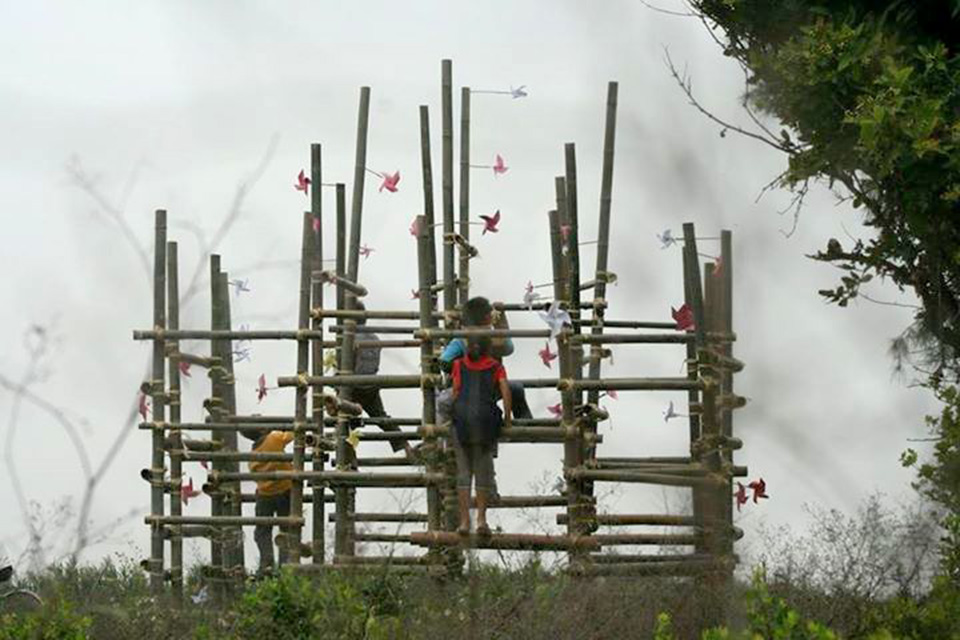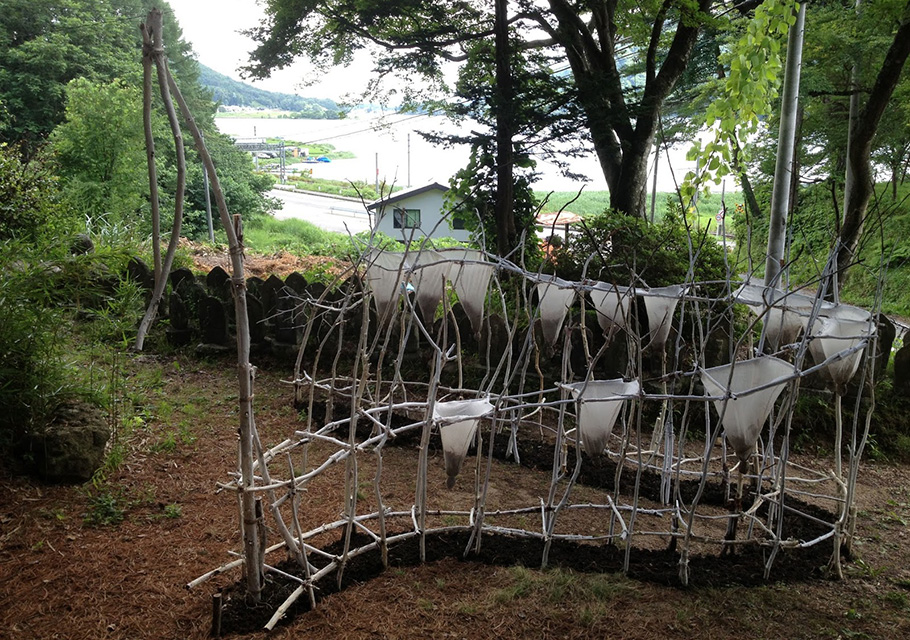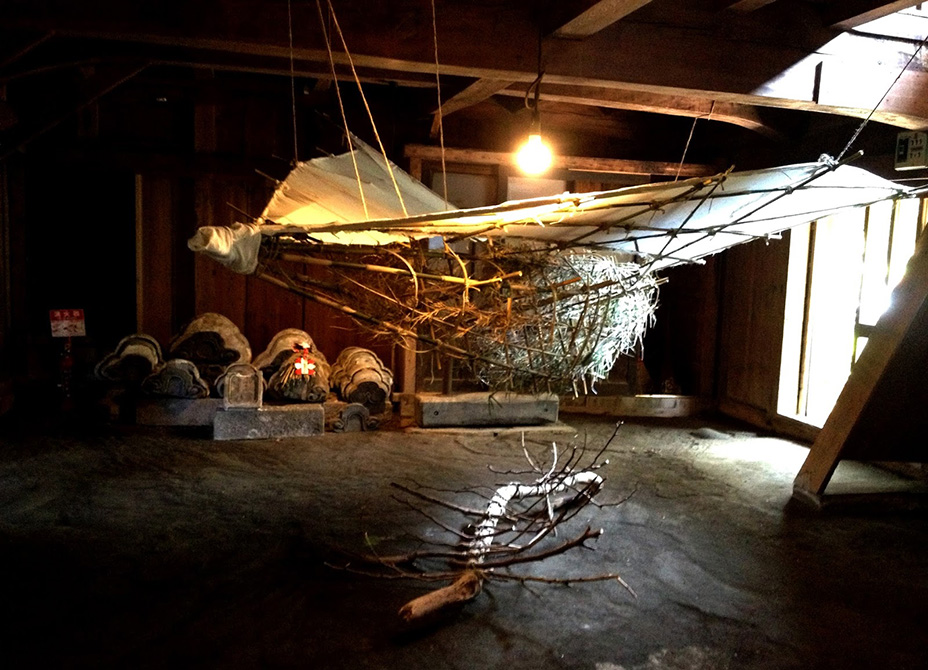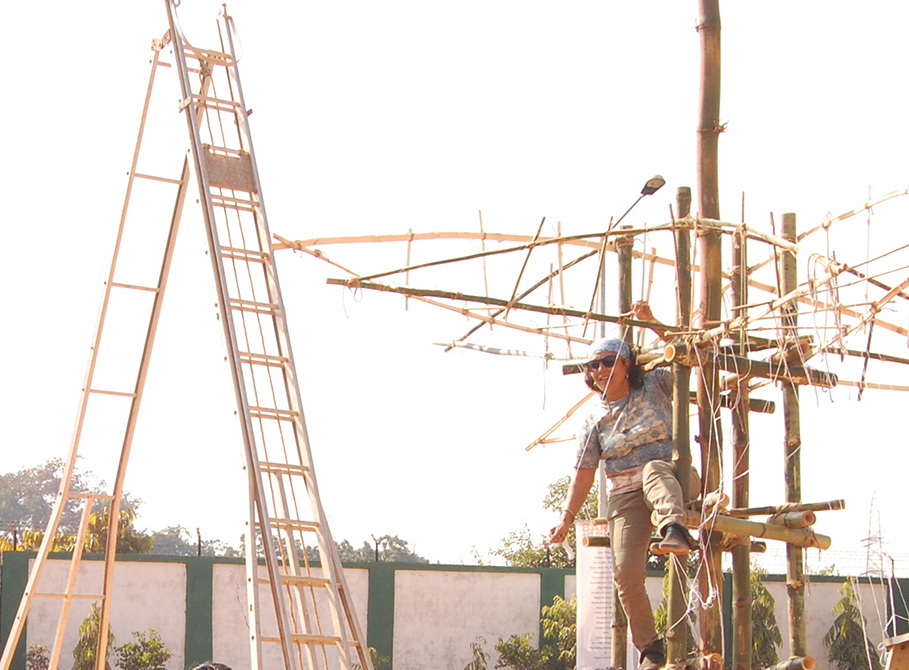The body is one of the most ephemeral objects one has ever seen, says renowned artist Shilpa Joglekar in a conversation with Samudra Kajal Saikia.
Shilpa Joglekar is a dynamic person with artistic engagements in diverse areas. She believes her art and art projects are “aimed to involve an entire society, not just art enthusiasts”. Scale, materiality and a provocation towards dialogue—these are key features in Shilpa’s work. In a time when most female artists in our country are choosing to work with intricacy, privacy and minuteness, Shilpa’s work swims against the tide with its bold, large-scale and massive structural expression. They are mostly site-specific and interactive, inviting spectators to participate physically, and hence ephemeral in nature.
 Box of Wind Mills -Chen Long Wetlands International Environmental Art Project, 2010
Box of Wind Mills -Chen Long Wetlands International Environmental Art Project, 2010
The head of the department in Rachana Sansad, Mumbai, Shilpa has an M.A. in Ancient Indian Culture from Mumbai University. She did her B.F.A. from Sir J.J. School of Arts Mumbai and also studied ceramics under the noted potter Nirmala Patwardhan. She won the Prabhakar Barve Award in 1998, the Citibank Award and CMC India’s Young Printmaker Award in 1989, the Camlin Award in 1984 and a scholarship from the French government in 1993. She has had a number of solo shows: at the Triveda Gallery atTravencore House in Delhi, the Pat Bungner Studio and Galerie du Haute-Pavé in Paris, Gallery Sudarshan in Pune, and Mumbai’s Cymroza Gallery.
Shilpa is not a performance artist, but there are certain performative elements in her community-based projects (in Japan, Korea and Taiwan, as well as closer home) . We began our conversation by talking about certain aspects of performative or ephemeral artistic expressions. When one’s expression is ephemeral and situated in a certain time and space, photographic documentation becomes important for the artist’s individual journey as well as evaluation. But once a work of art has been documented through a photograph, it is a different medium—photography. The same happens with moving images, as they too are converted into a different medium with different sensibilities, cutting them off from the specific context. A visual documentation, either in stills or in moving images, may be read as a work in itself. So the question arises: when she attempts an ‘ephemeral’ performative work, specific to a time and site, how much do the concerns around documentation matter to her? Does she keep in mind the post-performance presentation? Other than the specific ephemeral experience, does the visual appeal of the later documentation make her conscious?
 Snow Seed- Jara Island International, Baggat Art Exhibition
Snow Seed- Jara Island International, Baggat Art Exhibition
“Well,” Shilpa replies, “one has used the photographic image as you mentioned for purposes of documentation, extension or re-presentation of the work. In work that I make using the photographic image as the end result, the setting for the photograph is always pre-designed or created, and very often my ephemeral sculpture is placed in that setting to get the desired visual. In the process, the image becomes like a painting and is pre-orchestrated.
“But when one is working on an ephemeral, site-specific work, the documentation of the process becomes a visual documentary for oneself as a point of reference. In such situations, the documentation always lacks the energy of the actual act of performance or the process of the work in itself. It fails to carry the air, the sound, the smell of the space, and the interaction with the viewer. Most of the ephemeral work that is produced tends to lose these characters and one has to be very careful and address this with deep thought, even while making a presentation of the actual work itself.
 Mother Earth- Fertility Dragon, Primitive Sense International Art Festival, Japan2013
Mother Earth- Fertility Dragon, Primitive Sense International Art Festival, Japan2013
“For me, if the art is, unfortunately, ruled by commerce, the artist starts to take the re-presentation of the performance seriously and callously deals with the unknown and the spiritual experience within the act itself. So if more efforts are made like the KIPAF [the Kolkata International Performance Arts Festival] maybe it will get liberated from the politics of image creation and deal with an experience that is real and leave the entire aspect of authorship behind. It should be addressed seriously with performance artists when they choose a medium of expression that is so ephemeral and defies the concept of object-making, and then they turn to the documentation to used the photographic images as art objects. This is a little confusing for me.”
Reacting to a question about the emergence of contemporary performance art in India Shilpa says, “As far as my art practice is concerned, most of the issues that you have addressed in your question become a starting point to get into doing a performance. It can vary according to the time and space one is dealing with and the need to use it as a tool to reach a larger, more different audience. The narrative is for me very situation-based and does not necessarily delve on the same issues all the time. In the Indian art scenario, there are very few artists who use this space rightfully as most often there performances lead only to the creation of good photographic images that should have been meant for documentation and not making of a photographic work by itself.”
 Maya- Art Islands in TOKYO, 2013
Maya- Art Islands in TOKYO, 2013
Regarding our understanding of artistic expressions as disciplines, she feels that the habit of seeing is still narrowed down in our country. “In our country,” she says, “unfortunately the viewer is not at all trained to look at visual art. Most often people are not aware of an art form that involves the body, and hence only more and more artists working in the experimental space to push the art practice further will be able to change this understanding of the viewers in India.
“In Maharashtra, we had the ‘Vasudev’, who are part of a nomadic tribe and travel from one place to another. He is a performer propagating bhakti; he mostly works in the farm to make a living but sings abhangas and bhajans on the street. They were performance artists who spoke about socio-cultural issues in a very rich poetic form, who had colourful costumes. It used to be a delight to hear them early morning when they passed through villages. But this form of art is almost dying now, and not only that, people have forgotten that we did have a history of performance art here. This is just one example.”
 Installation at JJ School of Art
Installation at JJ School of Art
My next question is about the human body: “Have you ever thought over your bodily presence within the work, either in a subjective way or in some circumstantial ways?”
“The body for me,” she replies, “is one of the most ephemeral objects that one has ever seen. As an artist, the act of art-making in a way does involve the body in every sense. It’s a medium, a vehicle, a tool that enables to make the work, so there is always the indirect presence of the body. But to push this further, there is an urge to use this ephemeral self as a prop where identity can be erased, recreated for the narrative of the work. For me, the use of the body in the work is definitely subjective, unless you are dealing with not only your own body as a part of the work but with many others, then it can become circumstantial.”














